Humke Crew – Assigned 755th Squadron – September 11, 1944
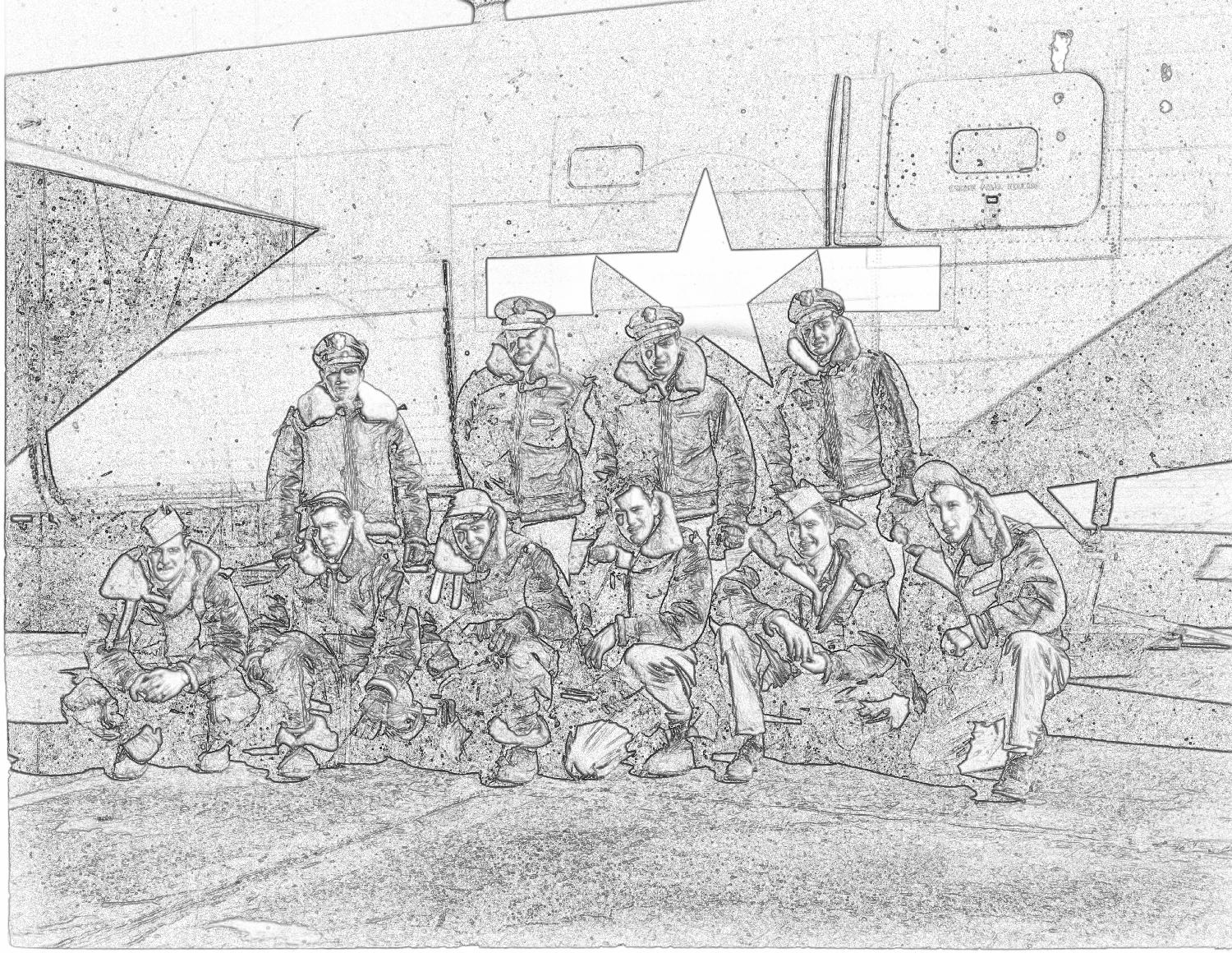
Crew Photo Needed
Crashed on take-off September 20, 1944 – AR 45-9-20-526
| Rank | Name | Serial # | Crew Position | Date | Status | Comments |
|---|---|---|---|---|---|---|
| 2Lt | Herbert H Humke | 0822170 | Pilot | 20-Sep-44 | KIA | Marathon County, WI |
| 2Lt | Glenn W Marr, Jr | 0827872 | Co-pilot | 20-Sep-44 | KIA | Cambridge American Cemetery |
| 2Lt | James D Garner | 02056374 | Navigator | 20-Sep-44 | KIA | Hall County, GA |
| 1Lt | Robert E Pettibone | 0773439 | Bombardier | 10-Mar-45 | UNK | Promoted to 1st Lieutenant - Kenyon |
| Sgt | Edward V Czernecki | 16118967 | Radio Operator | 20-Sep-44 | KIA | Cambridge American Cemetery |
| S/Sgt | Argel L Cool | 35754054 | Flight Engineer | 17-Apr-45 | UNK | Rest Home Leave - Ruark |
| Sgt | Robert H Kirby | 33723443 | Aerial Gunner, 2/E | 20-Sep-44 | KIA | Baltimore County, MD |
| Sgt | David W Moodie | 13082005 | Armorer-Gunner | 20-Sep-44 | KIA | Cambridge American Cemetery |
| S/Sgt | Joseph R Pfiffner | 37682331 | Aerial Gunner | 17-Apr-45 | UNK | Rest Home Leave |
| T/Sgt | Malcom H Shealy | 14181238 | Togglier - Nav? | 01-Dec-44 | UNK | Craven & O'Regan Crews |
2Lt Herbert H. Humke and crew were assigned to the 755th Squadron on September 11, 1944. The group had just come off of combat operations in order to help resupply General Patton’s Third Army with gasoline in France. Liberators from the 458th and other groups in the 2nd Bombardment Division were loaded with auxiliary fuel tanks in the bomb bays and waist sections and these were loaded with 80 octane fuel for Patton’s tanks. Crews consisted of a pilot, co-pilot, navigator, radio operator, engineer and one gunner – “just in case”. Most flights originated at Horsham St. Faith and ended up in either Clastres or Lille, France where the gas was unloaded into drums and Jerry cans and the crews were then to fly back to Horsham and start the process all over again. These were referred to as “Truckin’ missions“.
On September 12th, 12 aircraft and crews were able to haul 13,000 gallons to France. Things were hampered by the fact that hand pumps were needed to remove the fuel from all of the auxiliary tanks into the drums and cans at the destination. Engineers eventually devised a quicker method and flights picked up in intensity. On September 25th, the peak day, no fewer than 67 of the groups Liberators hauled a total of 107,727 gallons of gas to France. There were 50 sorties a day from then on until the operation came to an end on September 30, 1944. The group had brought a total of 737,160 gallons of gas to Patton in a two-week period. This was not without its costs.
The 458th lost two six-man crews on these operations. On September 23rd, after having spent the night at their French base, the crew of 2Lt George J. Koehn took off and evidently strayed into enemy skies, for they were shot down by anti-aircraft guns over the coast. Only one man was able to bail out and he spent the rest of the war in a German POW camp. Also on the 23rd, the crew of 1Lt Kermit A. Wagner, flying a borrowed ship from the 44th BG named Shack Rat, cracked up on landing in France. The injuries to the crew was light, but the aircraft was written off.
The other crew loss came three days earlier on September 20th at the other end of the operational zone – at Horsham St, Faith. Lt Humke and five of his crew were assigned a war-weary 755th Squadron ship named Gator. This aircraft had only flown on 27 combat missions, but those missions had taken their toll. The aircraft had been declared, “unfit for tactical use” almost one month before. The aircraft was loaded with almost 7,000 pounds of fuel and the day was hot with no wind blowing – less than ideal take-off conditions with a heavily laden aircraft. Add to this an inexperienced pilot and the danger is multiplied. While Lt Humke had been checked out as proficient and ready to fly combat, this would be his first take-off in a fully loaded Liberator.
Missions
| Date | Target | 458th Msn | Pilot Msn | Serial | RCL | Sqdn | A/C Msn | A/C Name | Comments |
|---|---|---|---|---|---|---|---|---|---|
| 20-Sep-44 | HORSHAM to CLASTRES | TR04 | ACC | 42-7516 | K | J3 | T2 | GATOR | Crash on Takeoff |
B-24H-1-FO 42-7516 J3 K Gator
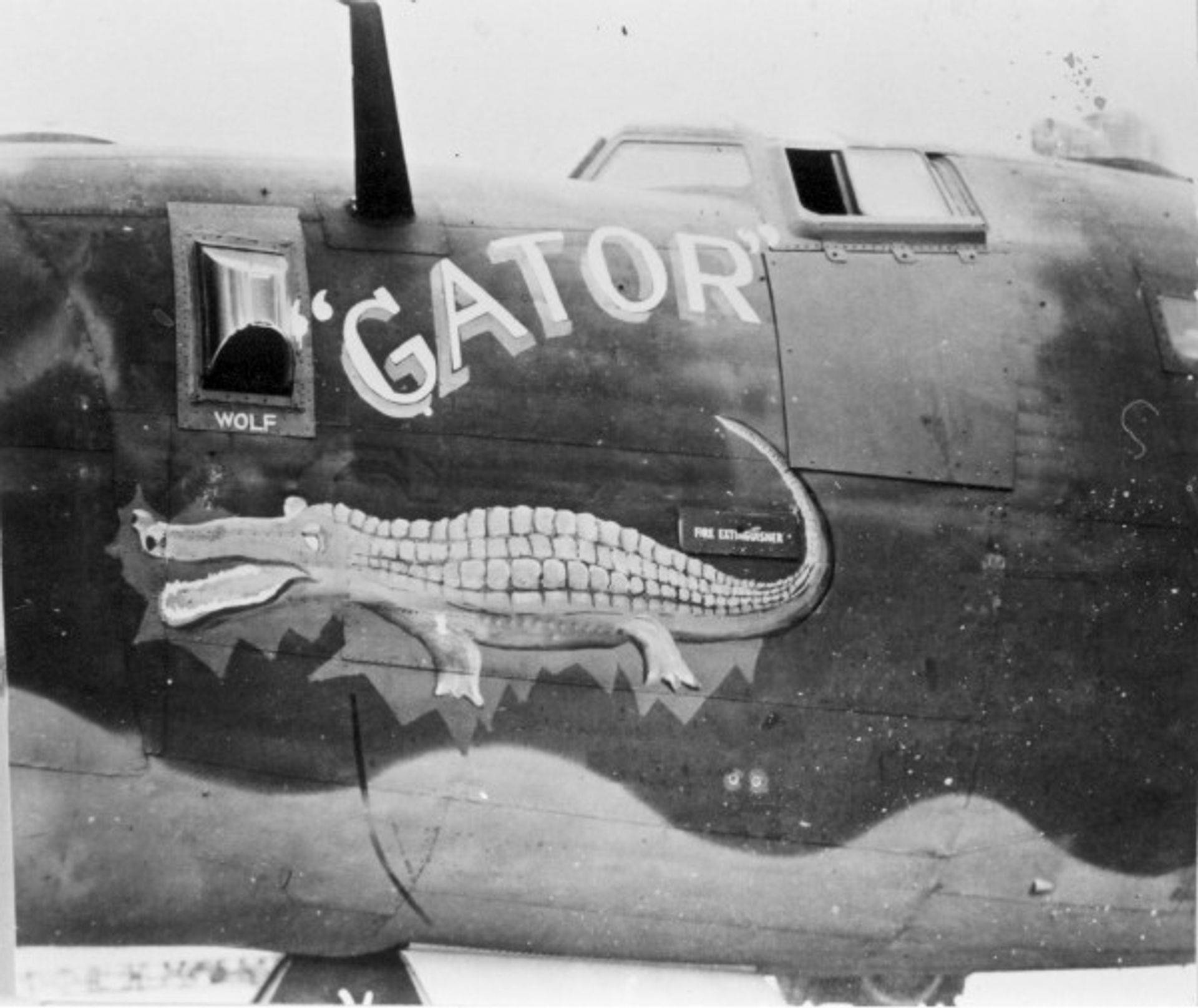
Artwork by T/Sgt John Spadone, Flight Engineer 752nd Squadron
(Photo: Mike Bailey)
Accident Report 45-9-20-526 – October 2, 1944
DESCRIPTION OF ACCIDENT
Approximately 1630, 20 September 1944, A/C B 24 H, 42.7516, assigned to the 755th Bombardment Squadron, 458th Bombardment Group (H), took off on R/W 23, AAF Station 123. At 1631 ½, this A/C crashed in Norwich, Norfolk County, England, around the vicinity of Hastings Avenue. All six members of the crew ere instantly killed and the A/C suffered a complete wreck by fire and impact. One civilian, a Mrs. Ethel Smith, was killed and five (5) civilians were slightly injured. Twenty (20) civilian homes were either damaged or completely destroyed by fire and impact of the A/C as it ploughed diagonally across Hastings Avenue. The resulting fire was enormous.
At the time of the accident A/C was employed in a trucking mission, hauling gasoline. It was loaded with three thousand five hundred thirty (3,530) gallons of fuel distributed as follows: two thousand (2000) gallons of one hundred (100) octane in the main tanks, four hundred fifty (450) gallons of eighty (80) octane in the auxiliary wing tanks, three hundred ninety (390) gallons of eighty (80) octane in a normal bomb bay tank installed in left front bomb bay, five hundred twenty five (525) gallons of eighty (80) octane in five (5) one hundred five (105) gallons capacity auxiliary tanks installed: one (1) in the front bomb and four (4) in the rear bomb bays, and one hundred sixty five (165) gallons of eighty (80) octane were installed in the waist in an auxiliary tank of that capacity. The resulting pay load was approximately seven thousand (7000) pounds not counting the weight in the Tokoyo [sic] tanks. This A/C had no ball turret.
At time of take-off the wind was practically a dead calm. Four (4) A/C similarly loaded took off before crashed A/C and one (1) behind it. After this the R/W in use was reversed one hundred eighty degrees (180°).
The Pilot, Lieutenant HUMKE, has approximately five hundred (500) hours total flying time and had had no operational missions but was checked and declared proficient for combat flying by his squadron commander, Major JAMISON of the 755th Bombardment Squadron. This was his first experience with a heavily loaded B-24 A/C.
The Assistant Group Operations Officer witnessed the take-off from the Control Tower and stated that the A/C used the entire length of the R/W before becoming airborne. He also stated that the nose did not appear excessively high at any time during the take-off run; that the engines sounded normal and that the Pilot seemed to have difficulty in getting A/C in air when the R/W gave out. Other eye-witnesses confirmed this.
The bomb bay door struck a six (6) foot high field lighting pole approximately three hundred (300) feet from end of R/W, continued on a straight flight clearing a two and a half (2 ½) story building some three (3) to four (4) hundred yards further on and crashed approximately one (1) mile south of R/W.
This A/C had been declared war-weary by the Group, however, the crew chief stated that both his and the Pilot’s pre-flight were normal. An inspection of the engineering forms showed no critical irregularities.
An inspection of the wreck showed the wing-flaps in the fully retracted position (see pictures), but no eye-witness was able to state positively whether this was the case at take-off or not.
It is the opinion of the undersigned that the take-off in question was made with either the wing flaps up, the cowl flaps open, with fouled up spark plugs or a combination of these troubles. The field lighting poles in question are a definite flying hazard that may or may not have been instrumental in causing this accident. Undoubtedly the Pilot’s inexperience was a contributing factor in this case. That the one hundred sixty five (165) gallon auxiliary tank installed in the waist could have broken its mooring and disrupted the center of gravity is improbable.
RECOMMENDATIONS:
a.Continued stress be made on the correct use of airplane check lists.
b.The field lighting poles in question were modified to eliminate the flying hazard, even though said poles were within specifications of British Standard equipment.
c.That inexperienced Pilots be reminded again and again the take-off characteristics of heavily loaded B-24 A/C with R/Ws of six thousand (6000) yards or less. In all cases brakes should be held until engines are at least two thousand (2000) R.P.M.s and the overtravel of supercharges be used in emergency.
RESPONSIBILITY:
The responsibility in this accident is unknown.
/SIGNED/
Col James H. Isbell – Group Commanding Officer
Lt Col James A. Hogg – Group Operations Officer
Maj William Routon – Medical Officer
Maj John H. Davis – Accident Board of Inquiry
Capt Ellwood T. Claggett – Accident Board of Inquiry
————————-
Eye-witness Statements

Photo taken immediately after crash. Note ominous looking “face” crated by the smoke.
(Photo: Harold Armstrong)
STATEMENT OF M/SGT AARON E. SCHMIDT, 6756594, Crew Chief of A/C 42-7516, 755th Bombardment Squadron (H)
RE: A/C 42-7516 B-24H CRASH 20 September 1944
The airplane operated normally when it was pre-flighted by Sergeant Hickey, and the undersigned. After the pilot taxied out for take-off, I returned to the hangar with the other men and we watched the airplane taking off. The wheels of 516 appeared to have left the ground just before reaching the end of the runway, but the tail skid was dragging or appeared so in the grass beyond the perimeter. It appeared the pilot could not get the tail up. The landing gear started to retract, but I do not know if it fully retracted or not. The airplane just cleared the pub at gate. Shortly after it appeared to level off temporarily, and then the tail dropped again and crashed.
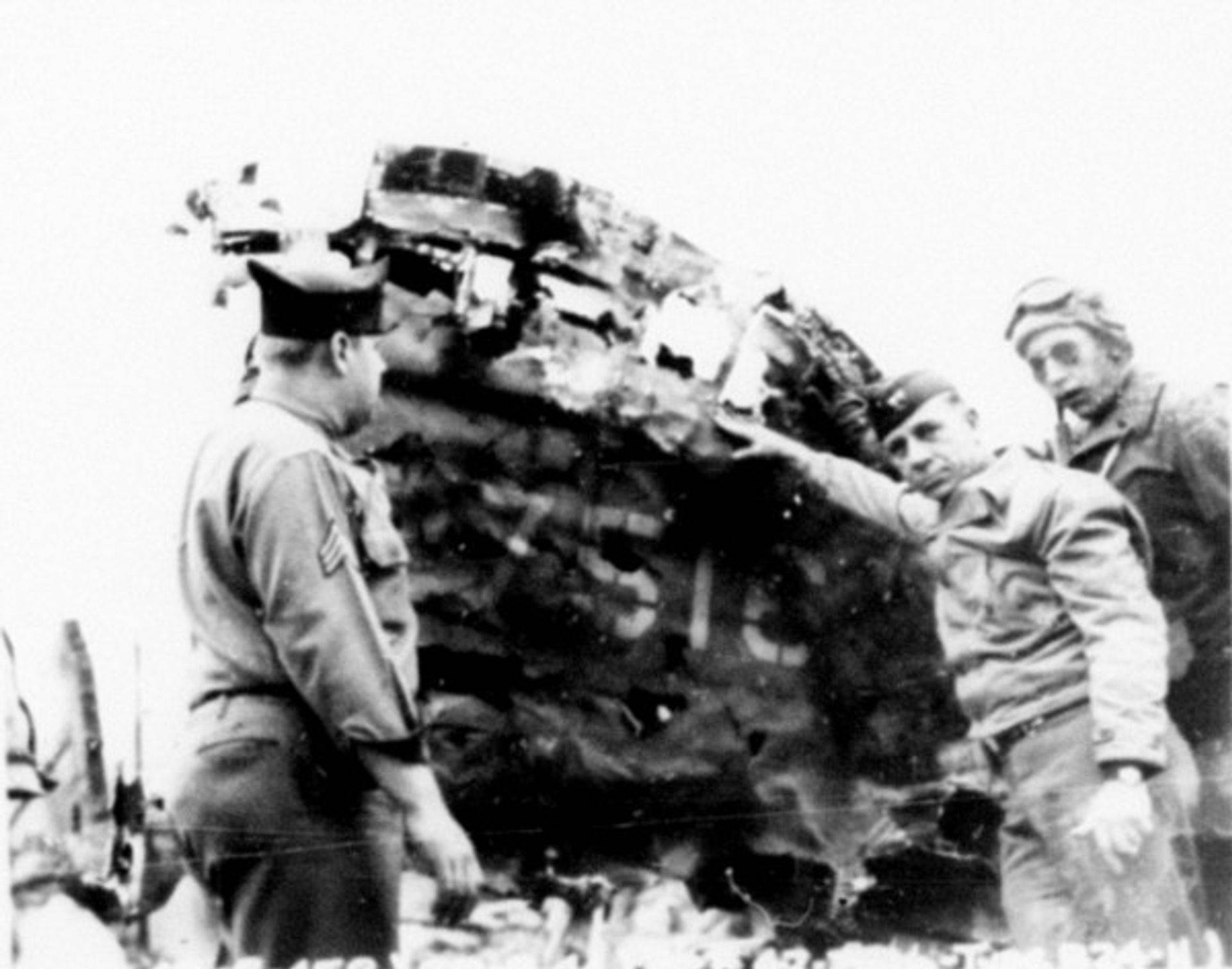
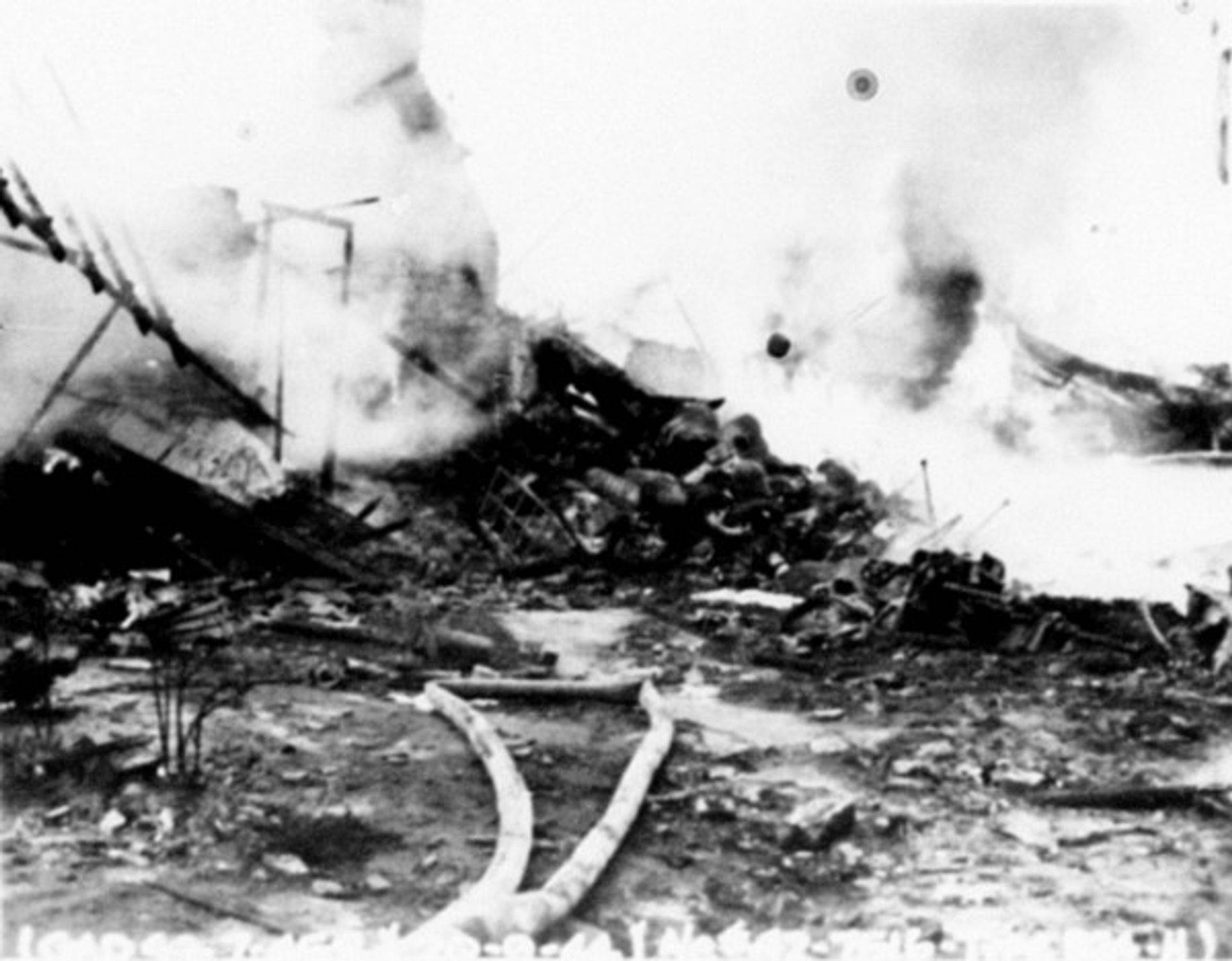
STATEMENT OF S/SGT FINNON L. KING, 14151196, Crew Chief of A/C 42-51179, 755th Bombardment Squadron (H)
RE: A/C 42-7516 B-24H CRASH 20 September 1944
I was riding in a truck approximately 150 yards from the end of the runway as the ship (42-7516) crossed the perimeter. The plane was mushing along with the tail skid almost dragging. It looked to me as if the pilot was trying to pull the ship up, and the tail was too heavy. At the end of the field the ship gained enough altitude to clear the light post, and the landing gear had started up. I couldn’t tell whether or not he had any flaps. After the ship cleared the light post it seemed to fly level for a moment, and then it looked as if he tried to pull it up again to clear some higher obstacles. The right wing went down and the ship immediately went down, and then there was a huge column of flame and smoke rising from the crash.
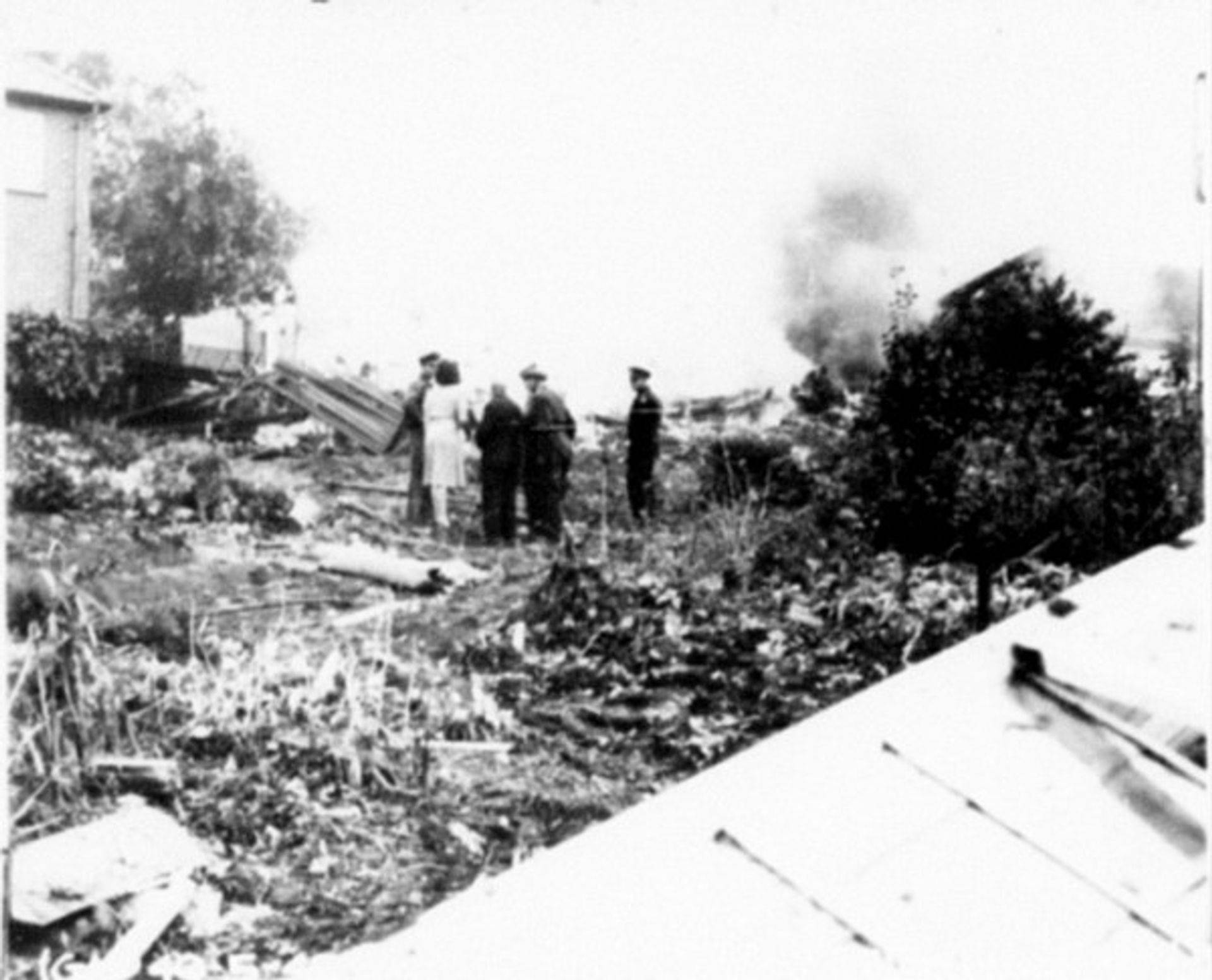
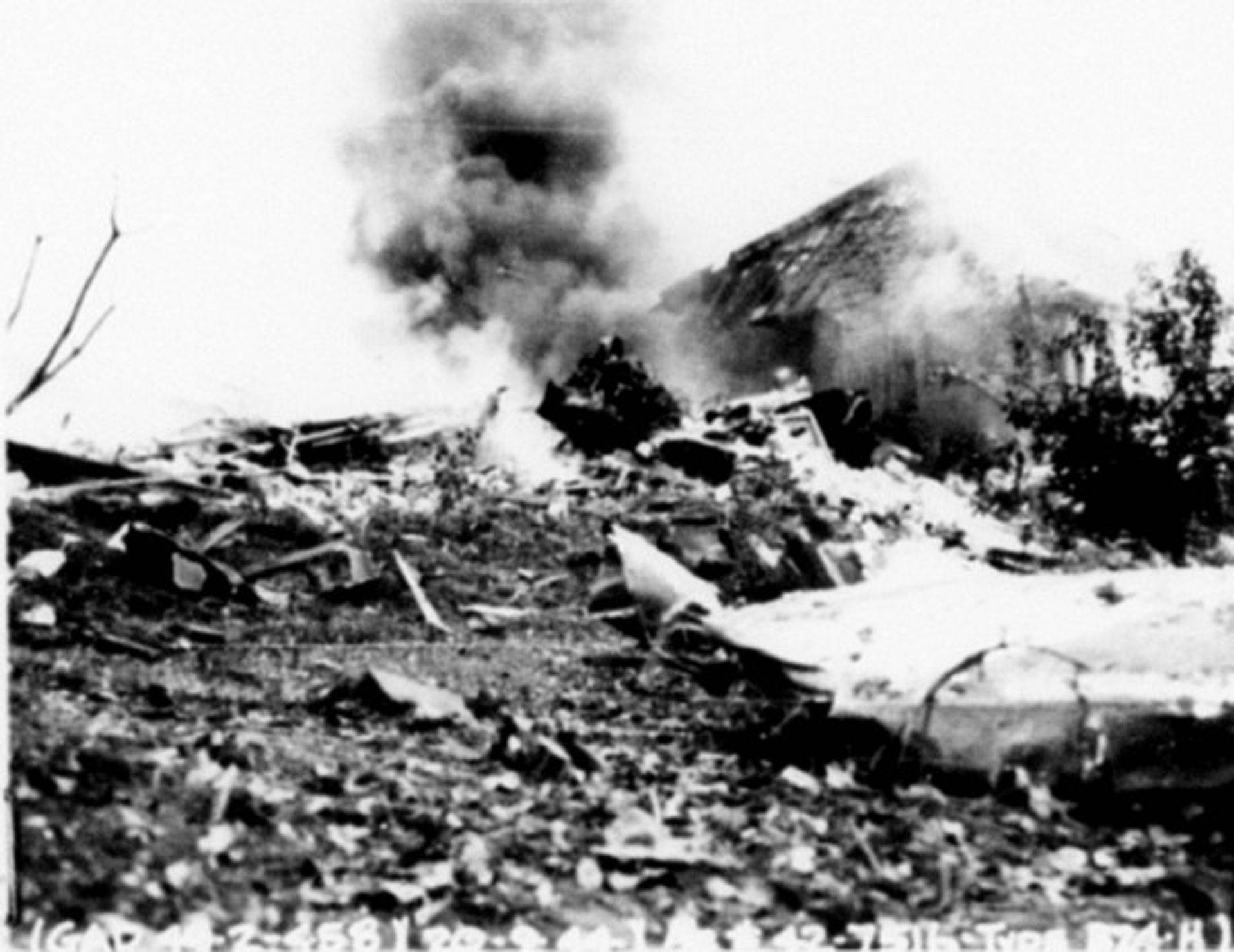
STATEMENT OF M/SGT CEDRIC E. WIDBER, 6130312, Crew Chief of A/C 41-29288, 755th Bombardment Squadron (H)
RE: A/C 42-7516 B-24H CRASH 20 September 1944
About 1630 hours 20 September 1944, four men including myself were coming by the 754th Dispersal Area on the Perimeter, when we noticed Ship No. 516 taking off. My reason for noticing especially was its more than usual tail low attitude. I believe the ship was clear of the ground when it crossed the perimeter at the end of the runway, but it was doing what is called “Grass Cutting”, that is just staying clear of the grass. All four engines sounded like they were pulling good, yet at the time, I mentioned it looked like a crash. This was because of the very tail heavy attitude. Looked like it acquired about 50 feet altitude, by what is known as hanging on the props. It was approaching buildings and looked to me like the pilot might be trying to pull up just a little more to ease over to the right a little to miss a building. Suddenly the right wing dipped and it fell off sharply to the right. I think the right wing tip would be the first part of the ship to hit as it was pointed almost straight down. Just as it hit flames immediately billowed up strongly. I couldn’t make a statement on wheels or flaps. The ship in my opinion never was in a normal flying attitude, or a position where flaps should be raised. It couldn’t have had a high airspeed dragging the wing in the position it was in.

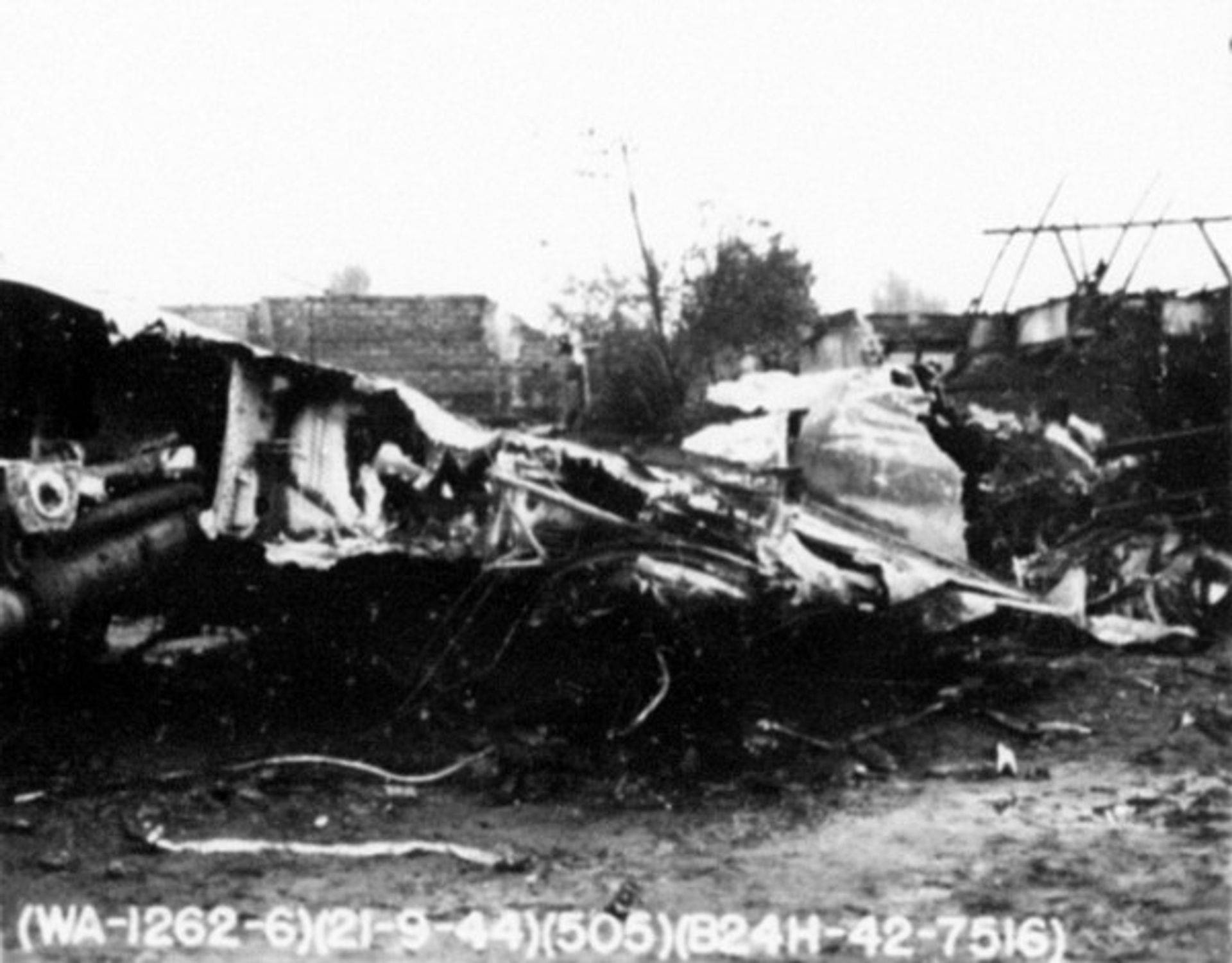
Gator declared “War-weary” – August 23, 1944

“Gator” in better days – inset photo is Lt Nelson Stewart’s Crew (#76)
(Painting courtesy: Bert Betts)
SUBJECT: Designation of Aircraft permanently unfit for tactical use.
TO: Commanding Officer, 458th Bombardment Group (H), AAF Station 123, APO 558.
1. In compliance with VIII Air Force Memorandum 65-21, dated 26 June 1944 and Letter, Headquarters 2D Bombardment Division, File Number 452.1, Subject, Authorized Aircrfat Strength, dated 4 July 1944, the following information is submitted in Airplane B-24H, A.C. No. 42-7516, recommended to be designated permanently unfit for tactical use.
a. Type, Mode, Series and Serial Number: B24H, 42-7516.
b. Unit to which assigned: 755th Bombardment Squadron (H). 458th Bombardment Group (H)
c. Total flying hours: 417:25.
d. Total operational hours: 175:00.
e. Total sorties completed: 27.
f. Total Abortions due to mechanical causes: 2.
g. Defects:
(1) Subject Aircraft landed when nose wheel was retracted while being ferried to the U.K. and seemed to have had no preventative maintenance while undergoing repairs. The Aircraft had deteriorated to such an extent that excessive maintenance has been required since assignment to this Squadron. This airplane was a year old before it was used for tactical purposes.
(2) Oil supercharger regulators have constantly required excessive maintenance and was the cause of the abortions.
(3) See attached pilots certificate.
h. Aircraft is available for re-assignment, may be picked up any date on twenty four (24) hour notice.
i. Aircraft is flyable.
j. Statement by the Station Technical Inspector inclosed [sic].
/Signed/
Maj Donald C. Jamison
755th Squadron Commanding Officer
755TH BOMBARDMENT SQUADRON
Office of the Operations Officer
It is my opinion that the B-24 a/c #42-7516, is unfit for further tactical service because of some very undesirable flight characteristics. The a/s seems to be immune to trim tabs. It flies wing low and develops a vibration in the right wing at several air speeds. It requires excessive power to hold formation. This is particularly true at high altitudes.
Because of constant supercharger troubles it is not possible to synchronize the throttles. This causes uneven power distribution when “jockeying” in formation and increases the difficulty with which a position is held.
NAME /s/ Arthur F. Kenyon
RANK /s/ 1st Lt A.C.
SER # /s/ 0-813714
Civilian Casualties
CASUALTY INFORMATION – HUMKE A/C 42-7516 B-24-H 20 September 1944.
Source of Information:
Mr. C. C. ROBINSON, Norfolk County Constabulary, Police House,
Hercules Road, Helsdon. Telephone: NORWICH 22841.
CIVILIANS KILLED
Mrs. Ethel Smith, 12 Hastings Avenue, Norwich, Norfolk, England.
(Next of Kin) Nephew: Gerald John Downs, 5956776, Pvt. Hq. Co.
Officer’s Mess Gibraltar Barracks,
Bury St. Edmonds, Suffolk,
Beds. & Hearts Regiment –
Local Address: 111 Drayton Road, Norwich
CIVILIANS INJURED
Louis Charles Makim Hough, Age 36 – Minor cuts on left leg.
21 Hastings Avenue, Norwich.
Patricia Carol Ann Hough, Age 6 – Minor cuts on head and bruises on chest.
21 Hastings Avenue, Norwich.
Jack Walter Hough, Age 12 weeks – Minor head injuries and bruises
21 Hastings Avenue, Norwich.
Mrs. Ida Trimby, Age 35 – Minor burns and shock
11 Hastings Avenue, Norwich.
Pat Trimby, Age 11 – Minor burns and shock
11 Hastings Avenue, Norwich.
NOTE: Local Press gave an account of one SIDNEY HOUGHTON, age 4 as being injured, however the police were unable to identify this person, or locate him in any way and their impression was that the press was in error in making that statement.
Daily Bulletin No. 253 – September 24, 1944
VOLUNTARY DONATIONS FOR OUR BURNED OUT NEIGHBORS
Among the tragic consequences of the recent crash of an aircraft from this field was the complete burning of practically all the possessions of five families. The amount of the welfare money received from the City is scarcely enough to keep these people going, much less rehabilitate them. Since we have a duty of neighborly kindness and charity, and since the Commanding General of this Air Force has expressed a personal interest in this case, it is requested that all personnel of this station respond as freely and whole-heartedly as their means will allow to a request for voluntary contributions to help our burned-out neighbors. Commanding Officers should immediately, and through 3 Oct 44, place in strategic spots, boxes marked “Voluntary Donations for Burned-Out Neighbors”. All proceeds should be turned over to the Station Special Service Officer. Personnel desiring to make larger contributions than the small change in their pockets may do so directly to the Special Service Officer. DIG WAY DOWN – WINTER IS COMING ON – AND THESE MIGHT HAVE BEEN YOUR OWN PEOPLE.
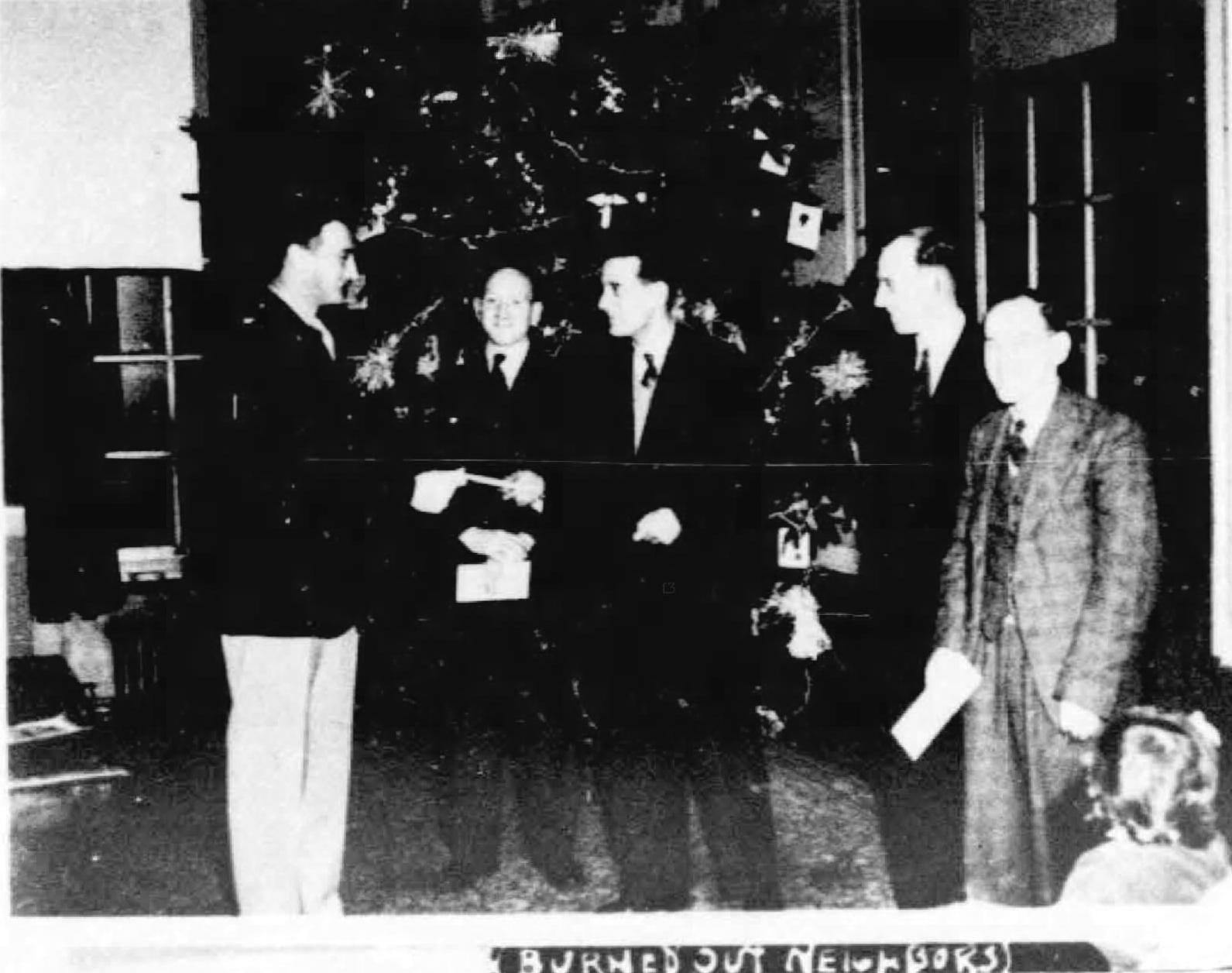
AN EIGHTH AIR FORCE LIBERATOR STATION, ENGLAND: Col. James H. Isbell (left) of Union City, Tenn., commanding officer of the 458th Bombardment Group, presents envelopes containing 32 pounds each to the heads of five families whose homes were damaged or destroyed by fire when one of the group’s bombers crashed onto a row of bungalows in an English city on September 20. The funds, totaling 160 Pounds, were voluntarily subscribed by officers and men of the group to help defray the loss of personal possessions by five families and were presented at a recent reception. Left to right: Col. Isbell, E. W. James, Leslie A. Trimby, Robert H. Rust, and Harry W. Palmer. The fifth recipient, not present for the presentation, was Mrs. Edith A. Kerridge. Six crewmen aboard the bomber lost their lives in the crash, and there was one civilian death.
Derek Palmer, Number 10 Hastings Avenue

I was born in January 1940 and lived with my Mum, Dad and Sister at 10 Hastings Avenue Hellesdon in the semi detached bungalow, next to our neighbour Ethel Smith who was killed that day.
My Grandmother lived on Reepham Road & my Aunt Edie lived opposite her. On the day of the crash one Saturday(?) in 1944 I was at my Grandmother’s house playing with my cousin Tony & my mum, dad & younger sister had gone shopping.
I was used to the loud noises of aircraft on the airfield nearby but still remember the extra loud noise followed by a tremendous crashing sound. Gran took us to see what had happened & all we could see was flames & I remember the heat.
We later learned our home had been destroyed, & our neighbour killed. I remember later on going back with my dad & searching in the rubble for anything that may have survived but there was nothing left, we also looked for Tiddles our cat who was seen after the crash but never returned back to the family.
I remember the Salvation Army was very kind to us & gave us clothes & we moved in with my Gran until the Council re-homed us, I also lost my toy panda & a wooden train my father had made me.
The photo above was taken afterwards, I am the boy standing on the right with my mother May Palmer, my father Harry with my sister Valerie in his arms. I was told this was taken at a party the Americans held for those involved but do not know any of the other people pictured –someone may know more – it was the first time I remember having ice cream.
Click here for copy of article by Derek James in the Norwich Evening News
Special thanks to Derek Palmer for his memories of that day and the photograph
